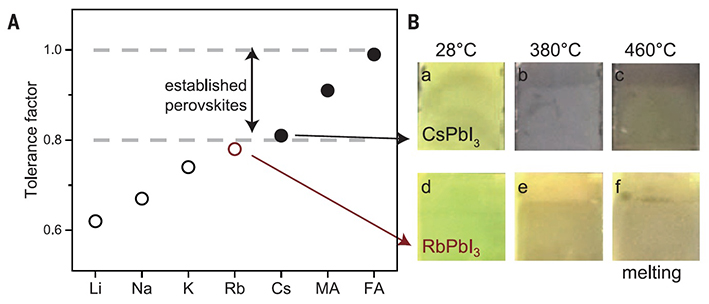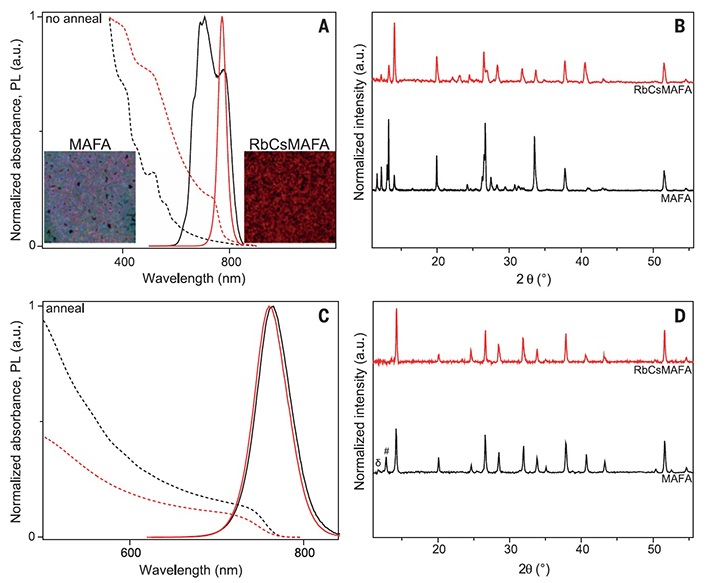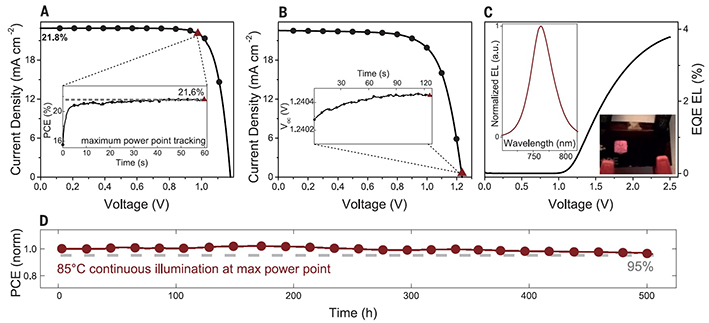The efficiency of perovskite solar cells has reached 22.1%. The chemical formula of perovskite is ABX3. High efficiency perovskite materials are all compounds of MA / FA (A), Pb (B) and halogen elements (X). Doping with more complex cationic compounds is an important means to improve the properties of perovskite, and the main purpose of doping with other cations is to improve the stability of perovskite. However, most of the monovalent cations do not meet the perovskite tolerance factor t formula: t = rA + rI /(rPb + rI), the tolerance factor values need to be between 0.8 and 1.0, but most of the elements are less than 0.8 cations. For example, Rb element can improve the oxidation stability of perovskite, but its tolerance factor is less than 0.8, so it has not been used for perovskite.
Recently, the Michael Gr tzel 1 team of the Federal Institute of Technology in Lausanne, Switzerland, embedded Rb ions into perovskite to form polycationic perovskite material RbCsMAFA (Rb content is 5%). The cell efficiency is as high as 21.6%, the open circuit voltage is 1.24V, and the band gap is 1.63 EV. The difference between the two is 0.39V, which is only 0.01V different from commercial silicon batteries. The doping of Rb ion keeps the perovskite stable and photoactive black phase, and 95% of the original properties can be maintained after 500 hours of sunlight irradiation at 85 C.

Fig. 1. tolerance factor and perovskite morphology at different temperatures. (A) The tolerance factor of each element is greater than 0.8 (dotted line above) with photoactive black phase, Rb is very close to 0.8; (B) The surface morphology of CsPbI3 and RbPbI3 when heated to different temperatures, both begin to melt at 460 C, and RbPbI3 has no black phase at all.

Fig. 2. characterization of the films before and after annealing. (A) The dotted line is the absorption of ultraviolet light, the solid line is the intensity peak of photoluminescence, the black line is the MAFA film before annealing, the red line is the RbCsMAFA film before annealing, and the illustration is the fluorescence micro-morphology of the two films; (B) the XRD image of the MAFA film before annealing and the RbCsMAFA film; (C) the MAFA film and RbCs after annealing Ultraviolet absorption image and photoluminescence intensity peak of MAFA film; (D) XRD image of MAFA film and RbCsMAFA film before annealing.

Fig. 3. cell efficiency, open circuit voltage, brightness and high temperature stability. (A) the J-V curve measured at the 21.8% maximum battery efficiency;
(B) J-V curve at 1.24V maximum open circuit voltage; (C) function of external quantum efficiency and electroluminescence intensity with respect to voltage. The illustration on the left is an electroluminescent spectrogram, and the illustration on the right is a solar cell with two active sites; (D) thermal stability testing of the cell. The tracking efficiency of the battery was measured at 85 degrees Celsius for 500 hours during the light irradiation.
By introducing Rb + ions into perovskite materials, the researchers explored different combinations of doped cations, and successfully used Rb + ions to improve the oxidation stability of perovskite, providing more possibilities for the doping process of perovskite.
Link: Incorporation of rubidium cations into perovskite solar cells improves photovoltaic performance (Science, 2016, DOI: 10.1126/science. aah5557)